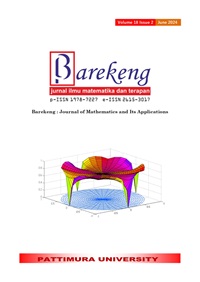APPLICATION OF QUADRATIC PROGRAMMING ON PORTFOLIO OPTIMIZATION USING WOLFE’S METHOD AND PARTICLE SWARM OPTIMIZATION ALGORITHM
Abstract
Stock portfolios can be modeled into quadratic programming problems using the Markowitz mean-variance model. Quadratic programming problems can be solved using two methods, namely classical and heuristic methods. In this research, the classical method uses Wolfe’s method, while the heuristic method uses the particle swarm optimization (PSO) algorithm. This research aims to determine optimal results in portfolio problems using two methods, namely Wolfe’s method and the PSO algorithm. The data used in this research is data from 10 stock companies that distribute the highest dividends in the IDX High Dividend 20 category for the 2022 period. The research results discuss the portfolios of PT Astra International Tbk and PT. Indo Tambangraya Megah Tbk. Based on the result, using Wolfe’s method, the ASII and ITMG stock portfolios are obtained, namely the optimal proportion of ASII shares = 0.76401 or 76.401% and ITMG shares = 0.23598 or 23.598%, while the PSO algorithm obtains a portfolio of ASII and ITMG shares, namely ASII shares = 75.02% and ITMG shares = 24.98%. Compared to Wolfe’s method, the PSO algorithm has a smaller Z value 5.7.
Downloads
References
F.S. Hiller, J. Gerald, & Lieberman, Introduction to Operations Research, The McGraw-Hill Companies, New York, 2021
L. P. Ling and Y. Dasril, “Portfolio Selection Strategies in Bursa Malaysia Based on Quadratic Programming,” Journal of Information System Exploration and Research, vol. 1, no. 2, Jul. 2023, doi: 10.52465/joiser.v1i2.178.
P. K. Mandal, “A review of classical methods and Nature-Inspired Algorithms (NIAs) for optimization problems,” Results in Control and Optimization, vol. 13, Dec. 2023, doi: 10.1016/j.rico.2023.100315.
L. Hong, X. Yu, G. Tao, E. Özcan, and J. Woodward, “A sequential quadratic programming based strategy for particle swarm optimization on single-objective numerical optimization,” Complex and Intelligent Systems, 2023, doi: 10.1007/s40747-023-01269-z.
Syaripuddin, H. Suprajitno, and Fatmawati, “Extension of Wolfe Method for Solving Quadratic Programming with Interval Coefficients,” J Appl Math, vol. 2017, 2017, doi: 10.1155/2017/9037857.
S. Yahdin et al., “Combination Of KNN And Particle Swarm Optimization (PSO) On Air Quality Prediction,” BAREKENG: Jurnal Ilmu Matematika dan Terapan, vol. 16, no. 1, pp. 007–014, Mar. 2022, doi: 10.30598/barekengvol16iss1pp007-014.
A. G. Gad, “Particle Swarm Optimization Algorithm and Its Applications: A Systematic Review,” Archives of Computational Methods in Engineering, vol. 29, no. 5, pp. 2531–2561, Aug. 2022, doi: 10.1007/s11831-021-09694-4.
J. Aryento, F. Kusnadi, and D. Lesmono, “Calculation of Credited Interest Rate With Investment Year Method and Portfolio Method,” BAREKENG: Jurnal Ilmu Matematika dan Terapan, vol. 16, no. 3, pp. 787–796, Sep. 2022, doi: 10.30598/barekengvol16iss3pp787-796.
N. Nurwahidah, “Quadratic Programming: An Optimization Tool For Building Global Minimum Variance Portfolio With No Short Sale,” BAREKENG: Jurnal Ilmu Matematika dan Terapan, vol. 15, no. 2, pp. 305–314, Jun. 2021, doi: 10.30598/barekengvol15iss2pp305-314.
N. A. Halim and A. Yuliati, “Markowitz Model Investment Portfolio Optimization: a Review Theory,” International Journal of Research in Community Service, vol. 1, no. 3, pp. 14–18, 2020.
R. Z. Widia Putri, “Metode Particle Swarm Optimization Untuk Optimasi Portofolio,” STRING: Satuan Tulisan Riset dan Inovasi Teknologi, vol. 2, no. 3, pp. 233-240, 2018.
Z. Dai, “A Closer Look at the Minimum-Variance Portfolio Optimization Model,” Math Probl Eng, vol. 2019, 2019, doi: 10.1155/2019/1452762.
U. Muthohiroh, R. Rahmawati, and D. Ispriyanti, “Pendekatan Metode Markowitz Untuk Optimalisasi Portofolio Dengan Risiko Expected Shortfall (ES) Pada Saham Syariah Dilengkapi GUI Matlab,” vol. 10, no. 3, pp. 445–454, 2021, [Online]. Available: https://ejournal3.undip.ac.id/index.php/gaussian/
N. P. Hartono, O. Rohaeni, and E. Kurniati, “Menentukan Portofolio Optimal Menggunakan Model Markowitz,” Jurnal Riset Matematika, vol. 1, no. 1, pp. 57–64, Oct. 2021, doi: 10.29313/jrm.v1i1.162.
J. Matematika et al., “Perbandingan Pembentukan Portofolio Optimal Model Markowitz Dan Model Indeks Tunggal (Single Index Model) Pada Saham Indeks IDX30.” [Online]. Available: http://ojs.uho.ac.id/index.php/JMKS
M. S. Assof et al., “Manajemen Portofolio Menggunakan Metode Markowitz Untuk Memberikan Keputusan Bobot Optimum Investasi,” Jurnal Kajian Ekonomi dan Kebijakan Publik, vol. 7, no. 1, [Online]. Available: www.finance.yahoo.com.
M. Anugrahayu and U. Azmi, “Stock Portfolio Optimization Using Mean-Variance and Mean Absolute Deviation Model Based On K-Medoids Clustering by Dynamic Time Warping,” Jurnal Matematika, Statistika dan Komputasi, vol. 20, no. 1, pp. 164–183, Sep. 2023, doi: 10.20956/j.v20i1.27755.
X.-She. Yang, Nature-Inspired Optimization Algorithms (1st. ed.), Elsevier Science Publishers B. V., NLD, 2014
M. P. Dewi, “Optimasi Portofolio Pada Saham Pefindo 25 Dengan Menggunakan Model Markowitz (Studi Kasus Di Bursa Efek Indonesia),” Warmadewa Management and Business Journal (WMBJ), vol. 3, no. 1, pp. 32–41, 2021, [Online]. Available: https://ejournal.warmadewa.ac.id/index.php/wmbj
Copyright (c) 2024 Syaripuddin Syaripuddin, Fidia Deny Tisna Amijaya, Wasono Wasono, Shanaz Tulzahrah, Rara Suciati

This work is licensed under a Creative Commons Attribution-ShareAlike 4.0 International License.
Authors who publish with this Journal agree to the following terms:
- Author retain copyright and grant the journal right of first publication with the work simultaneously licensed under a creative commons attribution license that allow others to share the work within an acknowledgement of the work’s authorship and initial publication of this journal.
- Authors are able to enter into separate, additional contractual arrangement for the non-exclusive distribution of the journal’s published version of the work (e.g. acknowledgement of its initial publication in this journal).
- Authors are permitted and encouraged to post their work online (e.g. in institutional repositories or on their websites) prior to and during the submission process, as it can lead to productive exchanges, as well as earlier and greater citation of published works.






1.gif)



